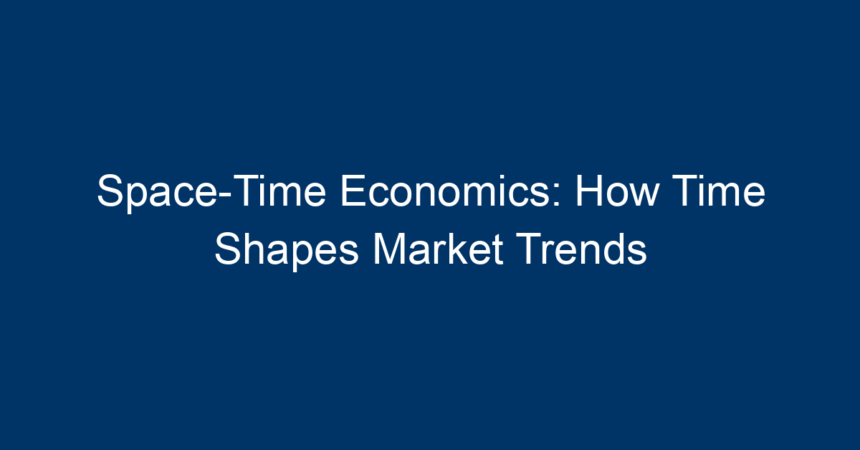In our fast-paced world, the interconnectedness of time and market dynamics has taken center stage. The concept of space-time economics examines how the dimensions of time influence economic models and market behaviors. As we delve into this intriguing realm, we’ll uncover how time not only defines market trends but also affects consumer behavior, investment strategies, and global trade patterns.
Understanding space-time economics can equip analysts, investors, and businesses with the insights needed to navigate the complexities of modern economies.
What is Space-Time Economics?
Space-time economics is a multidisciplinary approach that combines economic theory with principles of time and spatial dimensions. It studies how timing impacts economic activities and market transitions. Time can influence everything from consumer purchasing decisions to investment timelines.
Here’s why understanding space-time economics is crucial:
- Temporal Dynamics: Markets are not static; they fluctuate over time, influenced by seasons, cycles, and trends.
- Consumer Behavior: The timing of purchases and consumer confidence can shift market demand significantly.
- Investment Patterns: Recognizing optimal investment times can yield substantial returns.
By embracing space-time economics, stakeholders can better anticipate market movements and bolster their strategic positioning.
The Role of Time in Economic Theory
1. Historical Context
Traditionally, economic theories have emphasized the role of supply and demand, often neglecting the impact of time. The classical view shifted with the advent of behavioral economics, which acknowledged that human decisions vary over time.
For instance, considerations like price perception, urgency in buying decisions, and economic cycles illustrate how time affects consumer behavior and market conditions.
2. Cyclical Trends
Economic activities follow cycles—seasonal, business, and historical cycles. Understanding these patterns is essential in the field of space-time economics.
Seasonal Trends
Seasonal fluctuations can be observed in retail, agriculture, and tourism. For example, retailers gear up for holiday seasons, resulting in increased stock and marketing efforts. Analyzing past seasons can help predict future trends.
Business Cycles
From booms to recessions, businesses change strategies based on the phase of the economic cycle. The timing of launching a product, entering new markets, or investing heavily is often linked to these cycles.
3. The Time Value of Money
In finance, the concept of the time value of money (TVM) is pivotal. The value of money changes over time due to earning potential through investment or inflation.
For businesses, understanding TVM allows for better investment decisions:
- Investment Timing: Knowing when to invest can lead to higher returns.
- Cost of Capital: Companies can use TVM to make informed choices regarding financing and capital structure.
How Time Impacts Market Trends
1. Consumer Behavior and Purchasing Decisions
Time is a critical factor in consumer purchasing behavior. Marketing strategies often hinge on timing to maximize engagement. Here are a few elements to consider:
- Urgency: Limited-time offers create a sense of urgency, pushing consumers to make quicker decisions.
- Cultural Timing: Events like holidays and cultural festivals play a significant role in influencing spending patterns.
2. Technological Advancements
Technology has accelerated market changes, shaping consumer expectations and investor strategies.
- Real-Time Data Analysis: Companies now utilize real-time data analytics to respond to market shifts instantly. Rapid response times can lead to competitive advantages.
- Innovation Cycles: Technology advances in waves, influencing when products become obsolete or popular.
3. Global Trade and Economic Interactions
The global economy is becoming increasingly interconnected. Events in one part of the world can ripple through markets, demonstrating how time influences economic interactions on a global scale.
- Supply Chain Efficiency: Companies must adapt to ever-shifting time constraints in global supply chains. Delays can seriously impact profitability.
- Market Entry Timing: Companies entering foreign markets must carefully consider timing to align with local economic cycles.
Strategies for Harnessing Space-Time Economics
1. Implement Real-Time Analysis Tools
Businesses should invest in real-time analytics tools to gain insights into market trends as they occur. This allows for adaptive strategies that respond rapidly to changing conditions.
2. Prioritize Consumer Insights
Understanding consumer behavior is vital to successfully applying space-time economics principles. Regular surveys, focus groups, and data collection can illuminate how time impacts purchasing decisions.
3. Optimize Marketing Strategies
Timing your marketing efforts appropriately can enhance engagement and sales. Utilize seasonal trends and consumer behavior insights to plan campaigns effectively.
4. Adapt Investment Strategies
Embrace flexible investment strategies that consider both short-term and long-term horizons. This approach allows for better alignment with market trends as they evolve.
5. Focus on Global Timing
In a global marketplace, timing matters. Evaluate entry strategies in international markets, keeping local economic conditions, cultural nuances, and consumer behavior in mind.
Conclusion: The Future of Space-Time Economics
The exploration of space-time economics reveals a complex interplay between time and market dynamics. As we continue to evolve in our understanding of economic behaviors, the importance of timing cannot be understated.
By leveraging insights from space-time economics, businesses, and investors can anticipate market trends, enhance decision-making processes, and foster growth in an increasingly volatile environment.
In this age of rapid change, the ability to make timely and informed decisions will be the differentiator that sets successful enterprises apart. As you navigate your economic activities, remember: time is not just a measure—it’s a vital economic asset.
By implementing actionable strategies derived from an understanding of space-time economics, stakeholders can stay ahead of the curve, ensuring their relevance in the ever-evolving landscape of global market trends. Embrace the power of timing, and watch your success unfold.




